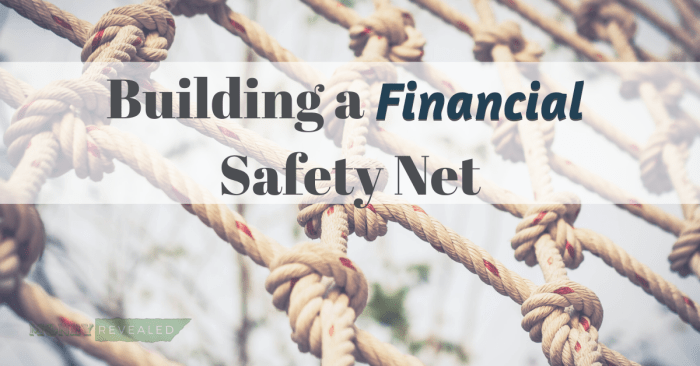When it comes to securing your financial future, having a safety net in place is paramount. This guide will take you through the importance of building a financial safety net, strategies to achieve this goal, emergency fund planning, and the role of insurance coverage in protecting your finances. Let’s dive in!
Importance of Building a Financial Safety Net
Building a financial safety net is crucial for financial stability as it provides a cushion for unexpected situations. Whether it’s a sudden job loss, a medical emergency, or a major car repair, having a safety net in place can help individuals navigate through tough times without completely derailing their financial well-being.
Benefits of Having a Safety Net
- Emergency Fund: A financial safety net allows individuals to have an emergency fund set aside, which can cover expenses during unexpected events.
- Peace of Mind: Knowing that there is a safety net in place can reduce stress and anxiety related to financial uncertainty.
- Opportunity for Growth: With a safety net, individuals can take calculated risks, pursue new opportunities, and invest in their future without the fear of financial instability.
Examples of How a Safety Net Can Help
- Job Loss: In the event of a sudden job loss, having a safety net can provide financial support while searching for a new job without falling into debt.
- Medical Emergency: A safety net can cover medical expenses not fully covered by insurance, ensuring individuals can focus on recovery rather than worrying about bills.
- Unexpected Expenses: Whether it’s a broken appliance or a major home repair, a safety net can help cover these unexpected expenses without disrupting the overall financial stability.
Strategies for Building a Financial Safety Net

Building a financial safety net is crucial for protecting yourself from unexpected financial setbacks. Here are some strategies to help you get started on creating a strong safety net:
Setting Financial Goals
One of the first steps in building a financial safety net is to establish clear financial goals. Determine how much money you need to save for emergencies, such as medical expenses or job loss, and set specific targets to work towards.
Saving Money through Budgeting
Budgeting is a key strategy for saving money and building a safety net. Track your expenses, cut down on unnecessary spending, and allocate a portion of your income towards savings each month. This will help you build a financial cushion over time.
Investing for the Future
In addition to saving money, consider investing as a way to grow your wealth and build a stronger safety net. Diversifying your investments can help protect your finances against market fluctuations and provide you with additional sources of income in the long run.
Emergency Fund Planning
Having an emergency fund is a crucial component of a solid financial safety net. It provides a cushion to fall back on in times of unexpected expenses or income disruptions, helping to prevent financial stress and debt accumulation.
What is an Emergency Fund and its Contribution to Financial Safety Net
An emergency fund is a stash of money set aside specifically for unforeseen circumstances like medical emergencies, car repairs, or sudden job loss. It acts as a financial buffer, allowing you to cover essential expenses without having to rely on credit cards or loans, thus safeguarding your financial stability.
Calculating the Ideal Amount for Your Emergency Fund
Financial experts recommend saving three to six months’ worth of living expenses in your emergency fund.
To calculate the ideal amount for your emergency fund, add up all your essential monthly expenses, including rent/mortgage, utilities, groceries, insurance, and debt payments. Aim to save enough to cover these expenses for at least three to six months. Adjust the target amount based on your individual circumstances, such as job stability, number of dependents, and health considerations.
Best Practices for Managing and Growing Your Emergency Fund
- Automate Your Savings: Set up automatic transfers from your checking account to your emergency fund to ensure consistent contributions.
- Keep Your Emergency Fund Separate: Maintain your emergency fund in a separate savings account to avoid the temptation of dipping into it for non-emergencies.
- Regularly Review and Adjust: Reassess your emergency fund target amount periodically and make adjustments based on changes in your financial situation.
- Utilize Windfalls: Direct unexpected windfalls like tax refunds, bonuses, or gifts towards boosting your emergency fund.
- Avoid Using Your Emergency Fund for Non-Emergencies: Reserve your emergency fund strictly for genuine emergencies to ensure its availability when needed most.
Insurance Coverage for Financial Protection
When it comes to building a solid financial safety net, insurance coverage plays a crucial role in protecting your assets and ensuring financial stability in times of need. Different types of insurance, such as health or disability insurance, can provide the necessary protection for various life circumstances. It is essential to evaluate insurance policies carefully to make sure they align with your financial safety needs.
Types of Insurance for Financial Protection
- Health Insurance: Covers medical expenses and helps prevent high bills in case of illness or injury.
- Disability Insurance: Provides income replacement if you are unable to work due to a disability.
- Life Insurance: Offers financial support to your loved ones in the event of your passing.
- Auto Insurance: Protects you from financial loss in case of a car accident.
Importance of Having the Right Insurance Coverage
- Prevents financial devastation in emergencies or unexpected events.
- Ensures peace of mind and reduces stress about potential financial risks.
- Protects your assets and investments from unforeseen circumstances.
Tips for Evaluating Insurance Policies
- Review coverage limits and exclusions to understand what is and isn’t covered.
- Compare quotes from different insurance providers to find the best rates and coverage options.
- Consider your specific needs and circumstances to tailor insurance policies to your requirements.
- Seek advice from a financial advisor to ensure you have the right insurance coverage for your situation.
